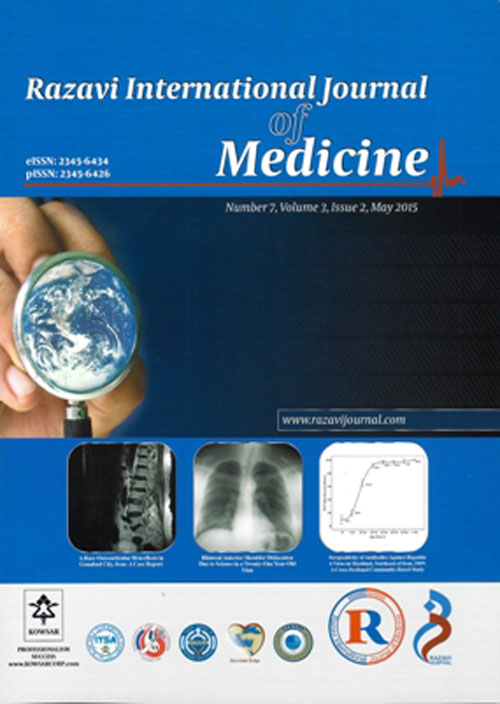فهرست مطالب

Razavi International Journal of Medicine
Volume:4 Issue: 1, Winter 2016
- تاریخ انتشار: 1394/10/11
- تعداد عناوین: 6
-
-
Page 3Background
Previous researchhasdemonstratedthatoppositionaldefiant is a strongpredictorofmental illness that cause significant distress for adolescents whomanifest the disorder and pose remarkable costs for society.
ObjectivesThe aim of this study was to investigate the role of callous-unemotional traits and emotion regulation difficulties in pre- dicting oppositional defiant disorder.
Materials and MethodsThis is a descriptive-correlative study performed on a sample of 320 male high school students, chosen via multi-stage random sampling. Instruments used to collect data are inclusive of oppositional defiant behavior inventory (ODBI), diffi- culties in emotion regulation strategies scale (DERS) and inventory of callous-unemotional traits (ICU).
ResultsThe results suggest a significant relationship between oppositional defiant behavior, impulse control difficulties and callous- ness. Regression analysis revealed that 16% variance of oppositional defiant behavior can be explained by impulse control difficulties and callousness.
ConclusionsOur findings highlight the importance of callousness and impulse control difficulties in development of oppositional defiantdisorder. Moving forward, clinicians should consider the importance of these variables intheir future researchto identifymech- anismthrough which callousness and impulse control difficulties enhances risk of oppositional defiant disorder
Keywords: Oppositional Defiant Behavior, Callous, Unemotional Traits, emotion regulation -
Page 4Background
It has been reported that three factors may be responsible for the social stigma associated with disease: widespread ignorance, little information andmisconceptions about the disease in society.
ObjectivesThis study is aimed to assess knowledge, attitudes, and beliefs about HIV/AIDS in residents of Mashhad, the largest city in northeast Iran.
Patients and MethodsA cross sectional study was conducted over three days, starting on December 1 2013, since this day was the World’s AIDS day. Each day the investigating group carried out the study in a different crowded place in the city. Using a convenience samplingmethod,members of the public were asked to fill in a questionnaire, which included the world health organization’s instru- ment for assessing knowledge, attitudes, and beliefs about HIV/AIDS. The data obtained were evaluated by frequency and percentage ratios, Chi-square ( 2 ),Mann-Whitney and Kruskal-Wallis tests, using the significance level P < 0.05.
ResultsThree hundred and eighty five individuals participated in this study. Themedian age was 27 years and the interquartile range was 21 - 45 years. The data analysis showed that most participants had good knowledge in this general domain: 70.2% of the answers in this domain were correct (47.1% in males and 23.1% in females). In general, the respondents’ attitudes toward AIDS were found to be tolerable and the total score showed significant differences according to educational level (P < 0.001). The majority of the respon- dents indicated that television, newspapers,magazines, and bookswere theirmajor sources of information about AIDS. Approximately 80% of participants needed specific information about the disease, with the preventionmethods being themost frequently requested information.
ConclusionsThis study showed that wemust putmore effort in translating knowledge into behavior.
Keywords: Knowledge, attitudes, beliefs, HIV, AIDS -
Page 5Background
Unusedmedicines in households are among the problems inmanymodern societies and developing nations. This issue leads to social and economical problems, and it is associated with other complications such as self-medication, poisoning, incomplete recovery, and suicide.
ObjectivesThe present study was carried out in Mashhad and aimed at determining the amount of unused medicines in Mashhadi households in 2013.
Patients and MethodsIn a cross-sectional study in 2013, three hundred householdswere selected through a cluster randomsampling with the help of 12 healthcare centers in Mashhad. Data were collected by applying a checklist and analyzed by SPSS 11.5. Descriptive indices, including central tendency and dispersion, and frequency distribution were applied to describe qualitative variables; and chi- 2,Man-Whitney, and Kruskall-Wallis to compare quantitative variables. Level of significance was set to P < 0.05.
ResultsThis study showed that the existence of unused drugs and the number of unused drugs in household have significant differ- ence in four zones (P = 0.01, P < 0.001). Also, health insurance coverage was statistically different in various health centers (P = 0.002). Also, there is a significant association between unusedmedication in the household and family size, father’s occupation, and a family member being a health professional, respectively (P value 0.02, 0.002, 0.04)
ConclusionsThe findings of this study and similar ones support that the amount of unusedmedicines inside houses has to be lowered by physicians prescribing a more reasonable number of drugs, giving consultation to patients, and raising public awareness. On the other hand, amechanismneeds to be applied in order tomake use of the drugs kept inside houses and reduce drug wastage.
Keywords: UnusedMedicines, Households, Society health, Healthcare system -
Page 6Introduction
Sectoral retinitis pigmentosa (RP) is a rare clinical condition.
Case PresentationWe present a 60-year-old femalewith a history ofmild night blindness and decreased vision in the left eye for about 15 years.
ConclusionsFundus examination revealed retinal pigmentary changes in the inferotemporal sector and reduced arterial caliber. In addition, fundus autofluorescence, fluorescein angiography,multifocal electroretinogramscans and electro-oculogramconfirmed these clinical findings. To the best of our knowledge, the present study is the first to describe sectorial RP in the inferotemporal sector of Iranian origin.
Keywords: Sectoral, Retinitis Pigmentosa (RP), Iran

